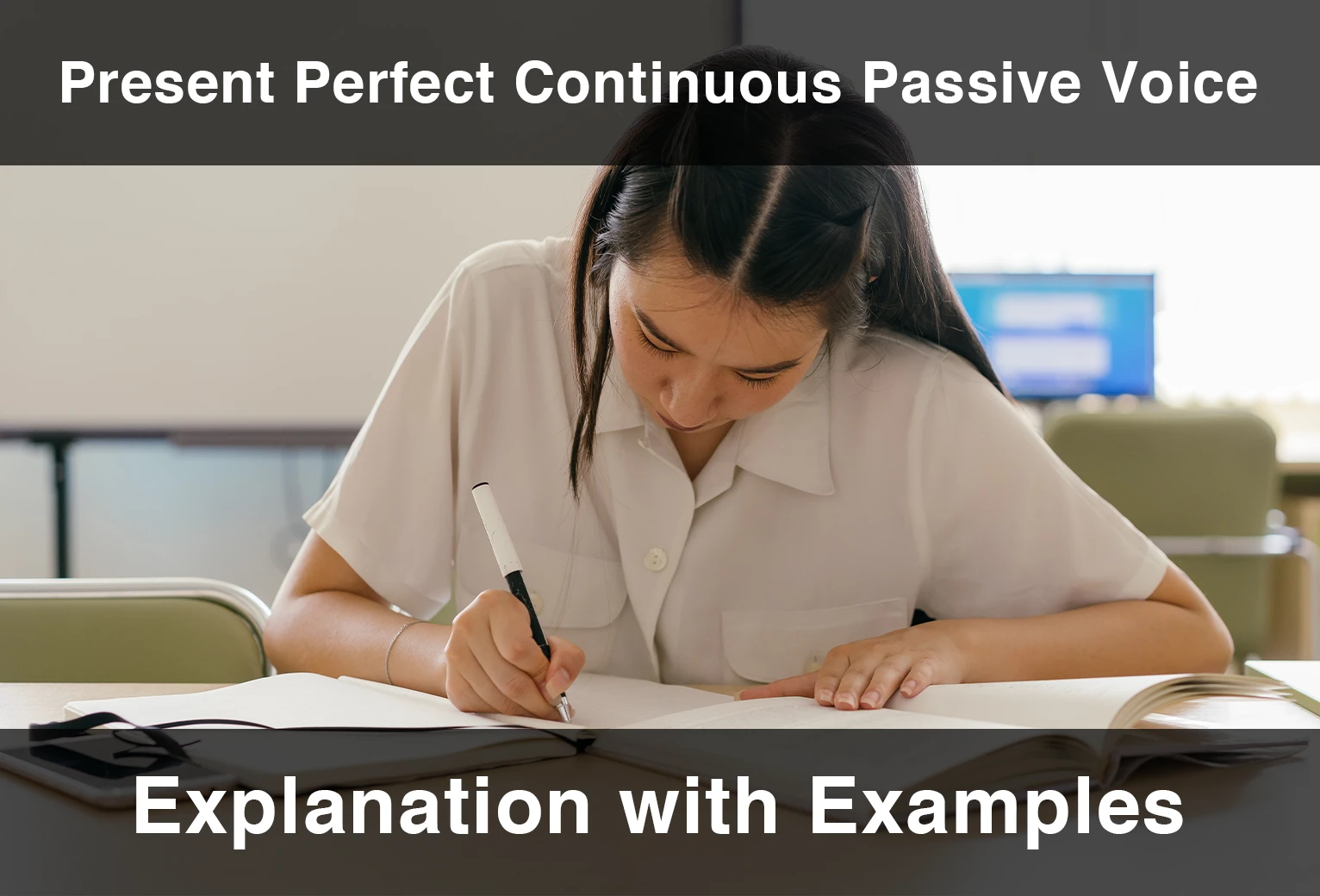When we speak English, we often use active voice. Active voice is when the subject of the sentence is the agent of the action. The subject is the doer of the action, therefore we know who is doing the action. But we can’t always use the active voice, and that’s when the passive voice comes in. In a passive voice, the subject is not the doer of the action. Who is doing the action is unclear or unknown. Passive voice is not as commonly used as its counterpart, active voice. But it still is an integral part of the English language, and to become fluent in English, we need to learn the passive voice. This article is prepared to help you learn all about the passive voice in Simple Present Tense.
How to Make Present Simple Passive Voice Sentences
To make a Present Simple Passive Voice sentence, we put the subject, the proper form of the auxiliary verb “be”, the past participle of the verb, and optionally “by ” and the agent of the action. Because the subject of the sentence is already there, even though it doesn’t indicate the agent of the action, it still is a complete sentence. Therefore, the last part is additional information and is optional.
Some points to consider when forming a simple present passive voice sentence:
Subject: The subject is the receiver of the action in the passive voice.
Auxiliary verb: The auxiliary verb “to be” is used in the simple present tense to indicate that the sentence is in the passive voice. The choice of the auxiliary verb depends on the subject: For singular subjects (he, she, it), we use “is”; for plural subjects (we, you, they), we use “are”, for first person singular subject (I), we use “am”.
Past participle: The main verb is changed to its past participle form. The past participle is formed by adding “-ed” to the base form of the verb.
“By” + agent (optional): The agent is the doer of the action. It can be introduced by the preposition “by” to indicate who or what performs the action. However, the agent is not always necessary or included in passive voice sentences.
We can form positive, negative, and interrogative sentences using Simple Present Passive voice. Let’s take a look at how to from these different types of sentences:
1. For positive Simple Present Passive voice sentences:
We use the formula of subject + auxiliary verb “to be” (am/is/are) + past participle of the main verb + “by” + agent (optional).
Active Voice: “They deliver the packages.”
Passive Voice: “The packages are delivered by them.”
2. For negative Simple Present Passive voice sentences:
We use the formula of subject + auxiliary verb “to be” (am/is/are) + negative adverb (not) + past participle of the main verb + “by” + agent (optional).
Active Voice: “He doesnt repair the car.”
Passive Voice: “The car is not repaired.”
3. For interrogative Simple Present Passive voice sentences:
We use the formula of auxiliary verb + subject + past participle + “by” + agent (optional).
Active Voice: “Do you clean the house?”
Passive Voice: “Is the house cleaned?”
Present Simple Tense Positive Passive Sentences
As we learned above, the formula we use to form Present Simple Tense Positive Passive sentences is subject + auxiliary verb “to be” (am/is/are) + past participle of the main verb. Here is a table and some examples to help you better understand.
| Subject | Auxiliary Verb (be) | Verb |
|---|---|---|
| I | am | V3 |
| He/She/It | is | |
| You/We/They | are |
Active: She loves me.
Passive: I am loved by her.
Active: They left you alone.
Passive: You are left alone by them.
Active: The police arrested him.
Passive: He is arrested by the police.
Active: He kicked us out of his house.
Passive: We are kicked out of his house.
Active: They cleaned the couches.
Passive: The couches are cleaned.
Auxiliary Verbs: The auxiliary verbs “have” and “be” are used in combination. “Have” indicates the present perfect tense, while “be” indicates the continuous aspect.
Present Simple Tense Positive Passive Examples
Here are 10 positive sentence examples in Present Simple Tense Passive voice.
The chores are shared.
The car is washed every week.
The project is completed.
The desert is made by my mom.
The information is shared.
The room is messed up by the cats.
The songs are sung.
The report is prepared by the analyst.
You are invited.
The emails are sent to the clients.
Present Simple Tense Negative Passive Sentences
The formula for forming negative passive sentences in Present Simple Tense is subject + auxiliary verb “to be” (am/is/are) + negative adverb (not) + past participle of the main verb. Here is a table and some examples to help you better understand.
| Subject | Auxiliary Verb (be) | Negative Adverb | Verb |
|---|---|---|---|
| I | am | not | V3 |
| He/She/It | is | ||
| You/We/They | are |
Active: I didn’t write the book.
Passive: The book is not written by me.
Active: You didn’t bake the cake.
Passive: The cake isn’t baked by you.
Active: He didn’t clean the house.
Passive: The house isn’t cleaned by him.
Active: The secretary didn’t file the documents.
Passive: The documents aren’t filed.
Active: You didn’t water the plants.
Passive: The plants aren’t watered.
Present Simple Tense Negative Passive Examples
Here are 10 negative sentence examples in Present Simple Tense Passive voice.
The project is not completed by the deadline.
The exams are not graded.
The room is not cleaned by the housekeeper.
The problem is not solved.
The food is not cooked by the chef.
The report is not submitted to me.
The message is not received by the recipient.
The mistakes are not corrected.
The house is not maintained by the owners.
The documents are not filed by the assistant.
Passive Questions in Present Simple Tense
We learned the formula for Passive Questions in Present Simple Tense above in this article. The formula is auxiliary verb + subject + past participle verb for positive questions and auxiliary verb + subject + negative adverb + past participle verb for negative questions. Here are two tables and some examples to help you better understand.
Positive Questions:
| Auxiliary Verb (Be) | Subject | Verb |
|---|---|---|
| Is | He/She/It | V3 |
| Are | You/We/They |
Is the truck driven by her?
Is my package delivered?
Are the invitations printed?
Are the notebooks handed out?
Is the phone charger lost?
Negative Questions:
| Auxiliary Verb (Be) | Subject | Negative Adverb | Verb |
|---|---|---|---|
| Is | He/She/It | not | V3 |
| Are | You/We/They |
Is the house not repainted?
Is the committee not formed?
Are the mistakes not corrected?
Is the letter not written by her boyfriend?
Are the cookies not eaten by the class?
Passive Short Answer Questions in Present Simple Tense
To give short answers to Passive Present Simple Tense Questions, we write “Yes/No, it is/is not.” Here are some tables and examples to help you better understand.
Affirmative Answers:
| Affirmative Word | Subject | Auxiliary Verb |
|---|---|---|
| Yes | He/She/It | is |
| You/We/They | are |
Is your homework done? Yes, it is.
Are the apples washed? Yes, they are.
Negative Answers:
| Denial Word | Subject | Auxiliary Verb | Negative Adverb |
|---|---|---|---|
| No | He/She/It | is | not |
| You/We/They | are |
Is the birthday present bought? No, it isn’t.
Are our coffees ready? No, they aren’t.
Passive Wh- Questions in Present Simple Tense
To ask for more specific information, we can include question words in our passive voice questions. These question words include “who, what, where, when, how etc.”. To ask a passive question in Present Simple Tense with these question words, we utilize the formula of question word + auxiliary verb + subject + past participle verb. Here is a table and some examples to help you better understand.
| Question Word | Auxiliary Verb (Be) | Subject | Verb |
|---|---|---|---|
| who, what, where, when, how | Is | He/She/It | V3 |
| Are | You/We/They |
Who is the book written by?
What are the ingredients used for?
Where are your clothes manufactured?
How are the newly hired interns trained?
When is their wedding held?
Frequently Asked Questions About Present Simple Passive Voice
Here are some examples for Present Simple Passive voice sentences:
The exams are graded.
The flowers are cared for.
The bananas are eaten.
What are some examples of negative Present Simple Passive Voice sentences?
Here are some examples for negative Present Simple Passive voice sentences:
The books are not handed out.
He is not invited.
The computer isn’t fixed.
What are some examples of interrogative Present Simple Passive Voice sentences?
Here are some examples for interrogative Present Simple Passive voice sentences:
Is the food cooked?
Are the trees cut?
Is the letter sent?
What is the difference between active voice and passive voice?
In an active voice, the subject is performing the action. It is always known who is doing the action. In a passive voice, the subject is the receiver of the action. It is not always clear who is doing the action. To give the information about the carrier of the action, we use the preposition “by” followed by the agent of the action.
Would you like to put what you have learned into practice? You can access everything you need to learn English on a single platform! With 25-minute one-on-one live English lessons, 40-minute group lessons, more than 30,000 interactive videos, vocabulary learning tools, AI-supported tutor MiMi, quizzes, and interactive activities, EnglishCentral offers its users a personalized and quality education plan at an affordable price. How about registering for EnglishCentral now and starting to learn English?











